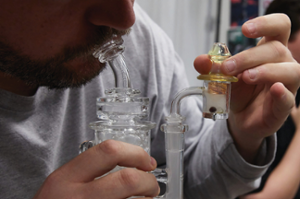Cannabis Consumption in Dispensaries: Public Health Implications of an Emerging Practice
Within the past few years, California and other states have legalized the smoking, vaping, and dabbing of cannabis inside the dispensaries where it is sold, as well as in cannabis lounges. All three forms of consumption release aerosols, including fine particulate matter (PM₂.₅), which can penetrate the lungs of people nearby. In a new study published in Environmental Health Perspectives, researchers from the University of California (UC), San Francisco, reported that concentrations of PM₂.₅ in one dispensary were 28 times higher during working hours than when the business was closed—a finding with potentially important public health and policy implications.
The researchers used two laser photometers to measure PM₂.₅ continuously over 5 weeks within the dispensary. Cannabis vaping and dabbing occurred at two tables at one corner of the room; this particular dispensary did not allow smoking. Over the entire 5 wk, the researchers measured an average 84μg/m³PM₂.₅ (plus or minus a standard deviation of 124μg/m³) during working hours and 3μg/m³ (±7μg/m³) when the business was closed. Comparing median concentrations across 2-hour intervals, the highest value, 76μg/m³, occurred during the period of 1700–1900 hours.
These values correspond to PM₂.₅ levels found in indoor spaces that allow cigarette smoking, according to the authors. However, they note that dabbing and vaping likely produce lower levels of PM₂.₅ than smoking cannabis in a similar space with similar ventilation because smoking creates more sidestream smoke. Sidestream smoke comes off a burning cigarette, joint, cigar, or pipe in between puffs. It is more toxic, per gram of particles, than mainstream smoke, which is directly inhaled. Secondhand smoke, which includes sidestream and exhaled mainstream smoke, is the most toxic of the three due to the effects of chemical aging and interaction with surfaces and other chemicals in the environment, says coauthor Suzaynn Schick, an associate professor of occupational and environmental medicine at UC San Francisco.
“I wasn’t surprised by our findings,” Schick says. “If you vape and dab indoors, you will increase PM₂.₅ the same as if you smoke, spray air freshener, or fry onions.” She expresses concern over the study’s potential public health implications, especially for employees and customers of dispensaries. Years of research have found no “discernible ‘safe’ level” of PM₂.₅ exposure.
“Ultimately, understanding the toxicity of the particulate matter generated by vaporization or dabbing is key to determining the potential health impacts of these particles,” says Peter DeCarlo, an associate professor of environmental health and engineering at Johns Hopkins University who was not involved in the study. “As the authors note, it is possible that the aerosols from vaporizers and dabbing are less toxic than standard combustion aerosols. This is a key aspect that should be investigated further.” He adds that using separate rooms for consumption may prevent emitted particles from spreading into the rest of the indoor space.
However, Schick’s own observations indicate that separate rooms do not eliminate exposures for employees, who must assist and supervise customers, as well as clean up afterward. “Normal room ventilation systems just aren’t made to control point sources of smoke or aerosol,” she says. “The vent hoods designed for restaurant kitchens, the fume hoods used in laboratories, a highly ventilated one-person phone booth—that sort of thing might work.”
“Cannabis has been consumed socially for a long time, but, when considering the licensure of social consumption lounges and events, we should assess potential environmental harms, including air quality and exposure for consumers and workers,” says Amanda Reiman, vice president of community development at Flow Cannabis Company and an internationally recognized cannabis expert and public health researcher. Reiman believes research like this can help develop best practices for workers and event attendees. “Requirements regarding consumption type in a given environment, air purification requirements, and worker safety can all be developed from this type of research,” says Reiman, who helped the researchers identify dispensaries for the study but was not otherwise involved in the research.
Schick started studying the chemistry and toxicity of cannabis aerosols so lawmakers would have data to guide policy decisions that protect the public. “If we make it OK to smoke cannabis around other people, we may also lose respect for and enforcement of clean air laws for tobacco. The public deserves a consistent policy that protects health,” she says. “If we do the research, educate people, and find ways to encourage safe uses and [the] protection of clean air and safe workplaces, we may be able to have legal recreational use without adding to the public health burden.”
This article was originally cited in the Environmental Health Perspectives.
MEDIA CONTACT
Susan Booker Woolard, booker@niehs.nih.gov

